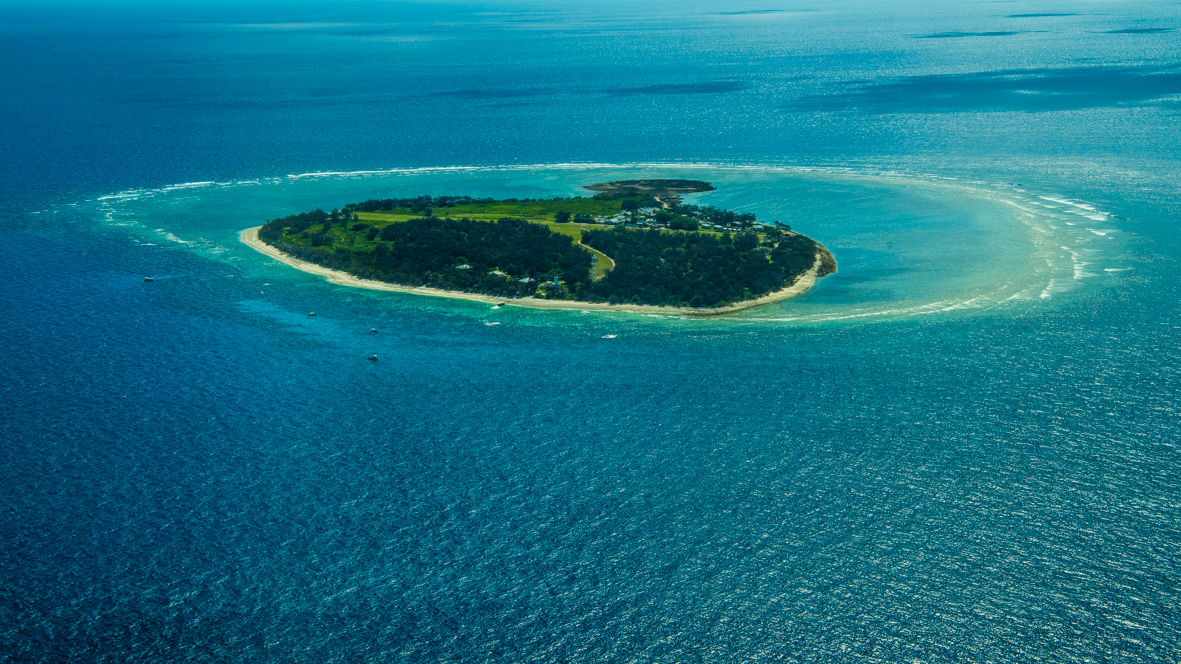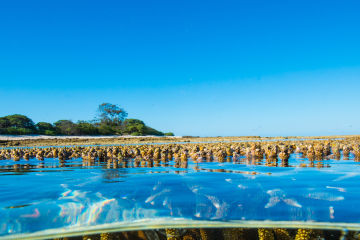Media Release ·
Reef island rescue plan to shore up climate change refuges

A network of climate change refuges will be established on five Great Barrier Reef islands with the launch of the first phase of a $AUD 14 million, 10-year program today by the Great Barrier Reef Foundation on Lady Elliot Island.
Lady Elliot Island on the southern Great Barrier Reef will be the first new climate change ‘ark’ included in the Reef Islands Initiative in 2018. A tailored on-ground action program will be developed to expand and accelerate the existing, award-winning environmental work already underway to further boost and accelerate the island’s resilience to climate change and other stresses.
Selected for its outstanding nature conservation values, Lady Elliot Island is one of the most important sites in the Great Barrier Reef World Heritage Area for seabird nesting and an important habitat for marine turtles, manta rays, dolphins, sharks and coral reefs.
UK-based Australian philanthropist Stephen Fitzgerald donated $AUD 1 million to establish the Reef Islands Initiative, a partnership that brings together the Great Barrier Reef Foundation, Great Barrier Reef Marine Park Authority (GBRMPA), Queensland Government and the Queensland Parks and Wildlife Service, island-based businesses and communities, and research and science agencies.
Environment Minister Steven Miles announced $3 million in matched funding for the Reef Islands Initiative from the Queensland Government.
Great Barrier Reef Foundation Managing Director Anna Marsden said protecting and restoring the Great Barrier Reef’s most precious land and sea scapes in the face of climate change is a priority in light of the current pressures facing the Reef.
“Islands are a critical part of the whole Great Barrier Reef ecosystem and play a key role in the life cycle of so many species of fauna and flora,” Ms Marsden said.
“Both global climate change and local threats are impacting Great Barrier Reef islands and these impacts are only projected to increase into the future, which is why we have to act now to ensure the most critical climate refuges are maintained,” she said.
‘Arks’ for the Reef
“By working to restore and protect these island refuges, we’re essentially creating a series of ‘arks’ to help our precious Reef wildlife and plants to survive in an increasingly challenging environment.
“Lady Elliot Island is one of five Great Barrier Reef islands/island groups we’ve prioritised for urgent action based on an assessment of biodiversity, conservation value, and threat level to these values carried out by Queensland Parks and Wildlife and the Great Barrier Reef Marine Park Authority.
“With the first stage of funding secured for the program, we will be bringing together an expert project team to work with Lady Elliot Island Eco Resort Managing Director Peter Gash and his team to develop a tailored program to boost the island’s resilience and provide a sustainable habitat for its amazing seabirds, turtles, manta rays, dolphins, sharks and coral reefs.
“We have to acknowledge the outstanding results already achieved by the current and previous custodians of Lady Elliot Island who have worked incredibly hard to restore it from its historical use as a guano mine site and to create an environmentally sustainable, award-winning ecotourism experience. The Foundation is thrilled to have the opportunity to take this great program to the next level with all of our partners.
“The project will be tailor made to meet the unique needs of the island. It will include elements such as developing detailed resilience and habitat maps for the island and its adjoining coral reefs, climate change impact modelling, piloting novel monitoring technologies such as acoustics, drones, under and above water automated vehicles, thermal imaging, machine learning and more. On ground adaptation and restoration activities and carbon mitigation will also form part of the overall program.”
Lady Elliot Island Eco Resort Managing Director Peter Gash said the project will build on and accelerate the award-winning work already underway to improve the island’s sustainability and contribute to a healthy Great Barrier Reef.
“Preserving the natural environment of the Great Barrier Reef is something that I am extremely passionate about,” Mr Gash said.
“Lady Elliot Island is a remarkable place that hosts some of the most extraordinary marine and terrestrial life and we need to do our best to look after them. It has the second highest diversity of breeding seabirds of any island on the Great Barrier Reef and is one of only two places on the Reef where endangered red-tailed tropic birds breed. Endangered loggerhead and green turtles also nest here and it’s renowned as a haven for giant manta rays and many other marine creatures.
“The island is also a recovering mine site which was intensively mined for guano in the late 1800s and stripped of all its vegetation and top soil. We’ve made great progress in working to revegetate it by planting over 4000 native trees but there is still more work to be done.
“Over 90% of the resort’s energy comes from our solar power plant and we’re aiming to achieve 100% sustainability by 2020.
“Working with the Great Barrier Reef Foundation, Queensland Government, Great Barrier Reef Marine Park Authority and other partners, this restoration project will be underpinned by strong science. We’re excited to be able to take the initiatives that we and the island’s previous custodians started to the next level and introduce new ones to ensure that Lady Elliot Island remains a biodiversity bright spot for the Reef into the future.”
The Reef Islands Initiative was made possible through an establishing investment from the former chairman of Goldman Sachs, Australia and New Zealand, Stephen Fitzgerald, who is now based in the UK.
“I’ve followed and supported the Great Barrier Reef Foundation’s work for many years and, while there are already significant initiatives underway to protect the Reef, it’s clear that the Reef needs more help to give it the best chance of a bright future,” Mr Fitzgerald said.
“Climate change is the number one threat facing the Great Barrier Reef today and the Reef Islands Initiative will improve the ability of some of the most important places on the Reef to withstand and survive our changing climate.
“Importantly, the program aligns with the goals of the Reef 2050 Plan and will help protect the outstanding values of our World Heritage site which has been valued at $56 billion by the recent Deloitte Access Economics report commissioned by the Great Barrier Reef Foundation.
“It’s a privilege to be part of this project with the Great Barrier Reef Foundation and its partners, and I hope that others will also support this quest to protect the world’s largest reef for generations to come,” he said.
Speaking from the Island, Minister for the Great Barrier Reef Steven Miles said the Government would contribute $3 million to the program to protect the Reef’s most precious land and sea scapes from climate change.
“Tackling climate change is vital for protecting our iconic places, including the Great Barrier Reef,” Mr Miles said.
“But global climate change and mass coral bleaching are impacting the islands.
“The advice of scientific experts is clear: action needs to be taken urgently to address climate change, and we need to accelerate our efforts to reduce other pressures.”
Great Barrier Reef Marine Park Authority Dr Russell Reichelt welcomed the work at Lady Elliot Island.
“We’re delighted to see a continuing focus on building resilience in the Great Barrier Reef, including islands,” Dr Reichelt said.
“Like all coral reefs around the world, the Great Barrier Reef is under pressure – climate change impacts on coral reefs are predicted to worsen and critically affect the survival of coral reefs globally without the strongest possible climate mitigation,” he said.
Ms Marsden said the new initiative builds on the momentum and success of another Reef island project supported by the Foundation.
“The Raine Island Recovery Project is working to restore the world’s largest green turtle nesting site with a coordinated program of science, intervention, innovation and on ground conservation,” Ms Marsden said.
“A key part of the Raine Island Recovery Project’s success has been achieved by working with local communities, businesses, traditional owners, scientists and government agencies to facilitate resilience-building to improve the outlook for the Great Barrier Reef.
“We’ll be applying this proven approach to the Lady Elliot Island project and to each of the island projects within this new Reef Island Refuge Initiative as they’re added.”
The Great Barrier Reef Foundation is working to confirm additional funding partners for the Reef Islands Initiative. These will be announced once specific funding commitments are agreed. The other priority Great Barrier Reef islands that will form part of this initiative will be announced when further project funding is secured.





